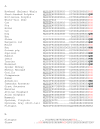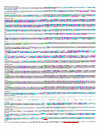Molecular evolution of dentin phosphoprotein among toothed and toothless animals
- PMID: 20030824
- PMCID: PMC2803795
- DOI: 10.1186/1471-2148-9-299
Molecular evolution of dentin phosphoprotein among toothed and toothless animals
Abstract
Background: Dentin sialophosphoprotein (DSPP) is the largest member of the SIBLING family and is the most abundant noncollagenous protein in dentin. DSPP is also expressed in non-mineralized tissues including metabolically active ductal epithelia and some cancers. Its function, however, is poorly defined. The carboxy-terminal fragment, dentin phosphoprotein (DPP) is encoded predominantly by a large repetitive domain that requires separate cloning/sequencing reactions and is, therefore, often incomplete in genomic databases. Comparison of DPP sequences from at least one member of each major branch in the mammalian evolutionary tree (including some "toothless" mammals) as well as one reptile and bird may help delineate its possible functions in both dentin and ductal epithelia.
Results: The BMP1-cleavage and translation-termination domains were sufficiently conserved to permit amplification/cloning/sequencing of most species' DPP. While the integrin-binding domain, RGD, was present in about half of species, only vestigial remnants of this tripeptide were identified in the others. The number of tandem repeats of the nominal SerSerAsp phosphorylation motif in toothed mammals (including baleen whale and platypus which lack teeth as adults), ranged from approximately 75 (elephant) to >230 (human). These repeats were not perfect, however, and patterns of intervening sequences highlight the rapidity of changes among even closely related species. Two toothless anteater species have evolved different sets of nonsense mutations shortly after their BMP1 motifs suggesting that while cleavage may be important for DSPP processing in other tissues, the DPP domain itself may be required only in dentin. The lizard DSPP had an intact BMP1 site, a remnant RGD motif, as well as a distinctly different Ser/Asp-rich domain compared to mammals.
Conclusions: The DPP domain of DSPP was found to change dramatically within mammals and was lost in two truly toothless animals. The defining aspect of DPP, the long repeating phosphorylation domain, apparently undergoes frequent slip replication and recombination events that rapidly change specific patterns but not its overall biochemical character in toothed animals. Species may have to co-evolve protein processing mechanisms, however, to handle increased lengths of DSP repeats. While the RGD domain is lost in many species, some evolutionary pressure to maintain integrin binding can be observed.
Figures




Similar articles
-
Dentin sialophosphoprotein (DSPP) is cleaved into its two natural dentin matrix products by three isoforms of bone morphogenetic protein-1 (BMP1).Matrix Biol. 2010 May;29(4):295-303. doi: 10.1016/j.matbio.2010.01.002. Epub 2010 Jan 15. Matrix Biol. 2010. PMID: 20079836 Free PMC article.
-
Molecular cloning of a human dentin sialophosphoprotein gene.Eur J Oral Sci. 2000 Feb;108(1):35-42. doi: 10.1034/j.1600-0722.2000.00765.x. Eur J Oral Sci. 2000. PMID: 10706475
-
DSPP contains an IRES element responsible for the translation of dentin phosphophoryn.J Dent Res. 2014 Feb;93(2):155-61. doi: 10.1177/0022034513516631. Epub 2013 Dec 18. J Dent Res. 2014. PMID: 24352500 Free PMC article.
-
Dentin sialophosphoprotein in biomineralization.Connect Tissue Res. 2010 Oct;51(5):404-17. doi: 10.3109/03008200903329789. Connect Tissue Res. 2010. PMID: 20367116 Free PMC article. Review.
-
Dentine sialophosphoprotein signal in dentineogenesis and dentine regeneration.Eur Cell Mater. 2021 Jul 18;42:43-62. doi: 10.22203/eCM.v042a04. Eur Cell Mater. 2021. PMID: 34275129 Free PMC article. Review.
Cited by
-
Phosphorylation regulates the secondary structure and function of dentin phosphoprotein peptides.Bone. 2017 Feb;95:65-75. doi: 10.1016/j.bone.2016.10.028. Epub 2016 Nov 1. Bone. 2017. PMID: 27810285 Free PMC article.
-
Mouse Dspp frameshift model of human dentinogenesis imperfecta.Sci Rep. 2021 Oct 19;11(1):20653. doi: 10.1038/s41598-021-00219-4. Sci Rep. 2021. PMID: 34667213 Free PMC article.
-
Pseudogenized Amelogenin Reveals Early Tooth Loss in True Toads (Anura: Bufonidae).Integr Comp Biol. 2021 Nov 17;61(5):1933-1945. doi: 10.1093/icb/icab039. Integr Comp Biol. 2021. PMID: 33905504 Free PMC article.
-
Dentin sialophosphoprotein (DSPP) is cleaved into its two natural dentin matrix products by three isoforms of bone morphogenetic protein-1 (BMP1).Matrix Biol. 2010 May;29(4):295-303. doi: 10.1016/j.matbio.2010.01.002. Epub 2010 Jan 15. Matrix Biol. 2010. PMID: 20079836 Free PMC article.
-
Dentin sialoprotein facilitates dental mesenchymal cell differentiation and dentin formation.Sci Rep. 2017 Mar 22;7(1):300. doi: 10.1038/s41598-017-00339-w. Sci Rep. 2017. PMID: 28331230 Free PMC article.
References
-
- MacDougall M, Simmons D, Luan X, Nydegger J, Feng J, Gu TT. Dentin phosphoprotein and dentin sialoprotein are cleavage products expressed from a single transcript coded by a gene on human chromosome 4. Dentin phosphoprotein DNA sequence determination. J Biol Chem. 1997;272:835–842. doi: 10.1074/jbc.272.2.835. - DOI - PubMed
Publication types
MeSH terms
Substances
Grants and funding
LinkOut - more resources
Full Text Sources
Miscellaneous

